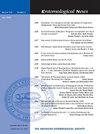墨西哥瓦哈卡州蝉杀手Wasp Sphecius convallis Patton捕食新记录(膜翅目:Crabronidae)及分布新记录
IF 0.4
4区 农林科学
Q4 ENTOMOLOGY
引用次数: 0
摘要
crabronid黄蜂属Sphecius包含21个描述的物种(Pulawski,2020)。其中有五个记录在《新世界》(Bohart,2000)中:Sphecius convallis Patton,1879年;S.grandis(Say,1823);S.hogardii(Latreille,1809);S.specious(Drury,1773)和S.spectabilis(Tasenberg,1875)。在墨西哥,只有三个物种被登记:康瓦利斯S.convallis、格兰迪斯S.grandis和特种S.specious(Holliday&Coelho,2006;Coelho等人,2011年)。锥状Sphecius convallis分布在墨西哥的11个州(图1A):下加利福尼亚州(Krombein,1979年;Ruíz等人,2002年;Coelho等人,2011年;Pulawski,2020)、南加利福尼亚州(Coelho et al.,2011;Pulawski2020)、奇瓦瓦州、科阿韦拉州、哈利斯科州、莫雷洛斯州、克雷塔罗州、圣路易斯波托西州、锡那罗亚州、索诺拉州(Coalho等人,2012年)和塔毛利帕斯州(Horta等人,2007年;Coerho等人,2010年)。在这项工作中,我们记录了瓦哈卡州的第一个对流S.convallis记录(图1A)。它是使用Holliday&Coelho(2006)的密钥识别的。本文章由计算机程序翻译,如有差异,请以英文原文为准。
New Record of Prey of Cicada Killer Wasp Sphecius convallis Patton (Hymenoptera: Crabronidae) and New Record of Distribution in Oaxaca, Mexico
The crabronid wasp genus Sphecius contains 21 described species (Pulawski, 2020). Of these, five are recorded in the New World (Bohart, 2000): Sphecius convallis Patton, 1879; S. grandis (Say, 1823); S. hogardii (Latreille, 1809); S. speciosus (Drury, 1773) and S. spectabilis (Tashenberg, 1875). In Mexico, only three species have been registered: S. convallis, S. grandis and S. speciosus (Holliday & Coelho, 2006; Coelho et al., 2011). Sphecius convallis is distributed in eleven states of Mexico (Fig. 1A): Baja California (Krombein, 1979; Ruíz et al., 2002; Coelho et al., 2011; Pulawski, 2020), Baja California Sur (Coelho et al., 2011; Pulawski, 2020), Chihuahua, Coahuila, Jalisco, Morelos, Querétaro, San Luis Potosí, Sinaloa, Sonora (Coelho et al., 2011) and Tamaulipas (Horta et al., 2007; Coelho et al., 2011). In this work, we record the first record of S. convallis from the state of Oaxaca (Fig. 1A). It was identified using keys of Holliday & Coelho (2006).
求助全文
通过发布文献求助,成功后即可免费获取论文全文。
去求助
来源期刊

Entomological News
生物-昆虫学
CiteScore
1.10
自引率
25.00%
发文量
17
期刊介绍:
Contributions are accepted on any of the aspects of systematics and taxonomy of insects. This includes: taxonomic revisions, phylogenetics, biogeography and faunistics, and descriptive morphology of insects. Taxonomic papers describing single species are acceptable if such a study is sufficiently justified, however, comprehensive studies that provide a comparative, integrated study of insect systematics and taxonomy will get priority.
 求助内容:
求助内容: 应助结果提醒方式:
应助结果提醒方式:


